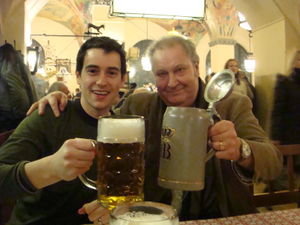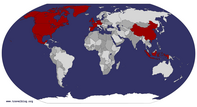Advertisement
Published: December 30th 2007

 Evan and Andreas
Evan and Andreas
Note his stein, we had the glass ones...So I am going to admit a little ignorance here, but when we were on our way to Munich we were googling what to do on the BlackBerry—I must have missed the history lesson that highlighted Munich as the birthplace of the Nazi Party, but once we made this discovery we did all we could to cram decades of history into 24 hours. Most of what I am going to write is about the history, so if you’ve been to Munich or happen to be a history buff…just look at the photos.
Our night began with a walk down the pedestrian shopping street for more sugared almonds, and ended at the Hofbräuhaus, the most famous beer hall in the world (or so they claim). This place is massive, and full of history…there are 6 major breweries in Bavaria, Hofbrau is one of them, and they all have their own beer halls, which are essentially giant cafeteria-style rooms that seat 100s of people. Each table can fit about 8 and you are encouraged to sit with people you don’t know. Walking in was a bit intimidating, while it is 80% tourists, many locals still frequent the place wearing lederhosen and drinking

 Hofbräuhaus Beer Lockers
Hofbräuhaus Beer Lockers
This is where the oldtimers store thier beer steins...the sink was right behind me where they have to wash it out at night before putting it back in the hold.a ton. If you’ve been drinking there for 15 years or more, you can have your very own stein, which is kept in a locker for 50 cents a month. When you come in, you take your stein, have it filled, and then wash it out when you’re done and put it back in your locker. In old times, there was no bathroom, instead there were troughs built into the floor, and men would open their lederhosen, pee in the trough below the table and then the restaurant would flush the entire beer hall with water at night to clean out the horrid smell…it should also be noted that when this was the norm women were not allow in…and I don’t think they’d want to come in anyway.
We found a seat a table of locals, they welcomed us because we were only two people, and they seemed like good guys. One older guy, Andreas the Professor, instantly took to us, and began chatting away in broken English. He wanted to know all about us, why we were in Munich, and what our family heritage was. Then out of nowhere he tells us a story about his childhood, during
the war, and how when he was six he would beg for care-packages from the American troops to bring home food to his family, otherwise they would starve. While we assumed it was taboo to bring up the war at a table of 60-something German men, the rest of the night was peppered with toasts to “United States” and “Frau-Clinton” as they called Hillary…they even joked about “good for us” winning the war.
We later learned that only 40% +/- actually voted for Hitler and that it shouldn’t be assumed that everyone was a supporter of his efforts. What is interesting about this beer hall is that it was one of Hitler’s favorites; Beer halls were popular places for holding political speeches because they were large and full of men…in Hitler’s time this one had swastikas painted on the ceiling, which are now painted over with Bavarian flags (photo attached).
Friday morning we woke up early and met up with a free tour (the guide works on tips)…he was Australian and this is important because many of the German-run tours do not highlight the significant city landmarks that were made infamous by the Third Reich. Our first stop
was the Glockenspiel at Marienplatz, the “new” town hall in the main square. This was the only building in the area to escape damage in WWII. Most of Munich was destroyed, and the city rebuilt in the original style…so some buildings, while post-war, were reproduced as exact replicas. The Glockenspiel is a moving merry-go-round of 40ish hand carved characters (photo attached)…a bit overrated, but neat to watch none the less. We next whet to the Frauen Kirche, the 2nd oldest church in Munich, this one is unmistakable because of its two tall spires with matching domes. The back of the church was blown out in the war, but the two spires remained intact as the Allies used them as landmarks from the air when they were bombing Munich.
The Old Town Hall, next on the tour, was completely destroyed and rebuilt with a Disney-like façade. It is probably one of the most significant spots because this is where Hitler learned of the German diplomat who was assassinated in Paris by a Jew. In this building the idea of starting a Holocaust was born. On that night Hitler ordered his plain-clothes officers to burn the homes and businesses of the

 Hofbräuhaus Ceiling
Hofbräuhaus Ceiling
Note the blue and white bavarian flags in the design, this is where the swastikas used to be.Jewish people and he ordered the Police and Fire Departments to stay home and not interfere. This became known as Kristallnacht because the glass from the houses covered the streets and it looked like crystal.
Next we moved onto Residenzestrasse, the site of Hitler’s failed attempt at mobilizing his supporters to march on Berlin in 1923. Hitler’s “Beerhall Putsch” which was years before the war, and the prelude to his jail-time, was a march that left 15 Nazi’s dead (plus one bystander they claimed) and Hitler’s bodyguard took 11 bullets for him…imagine what could have happened if just one had hit him?!?
When Hitler eventually came to power in 1933, he made it a law that everyone who passed this spot on the road had to give the Nazi salute to a plaque honoring the death of the 16 Nazis. Naturally there were many conscientious objectors at that time, and they refused to salute the sign at that spot on the road. Instead they took a short cut down an alley; Nazi guards grew wise to this and would record the names and times of people walking down the alley—if they found a pattern, those people were sent

 The New Town Hall
The New Town Hall
This was the one building in Marienplatz (the main town square) that remained intact after the war. I asked, it wasn't intentionally spared, just random.to jail. That alley became known as “Dodger’s Alley” and is today commemorated with the gold line painted down the center of the street.
After we de-thawed from our 4 hours walking around in the cold, we headed to Dachau, the first concentration camp in the Nazi system, completed in 1933 (years before the war began). It was a model for the others to be built on, and as such many photos were taken by the SS, which added to the displays. The site was massive, originally designed for 6,000 prisoners—at its height it housed 30,000 men, from all walks—Russian prisoners of war, ethnic minorities, literary types, scientists, allied troops, general prisoners, and anyone who opposed the war. The total number of men to have passed through Dachau is around 200,000, and the number of deaths is nearly untraceable because so many of them were unregistered or had a cause of death listed as a work related or disease.
The audioguides for the tour included narratives from survivors and the path you took was the exact one a new prisoner would take entering the camp. The conditions, as one can imagine, were appalling, the overcrowding disgusting, and the

 The Glockenspiel
The Glockenspiel
In the New Town Hall building“Roll Call” routine a daily torture. The food rations, the clothing, the harassment, the dawn till dark labor, the wide-spread disease…just unfathomable. The barracks have since been destroyed, but two were recreated to add to the memorial. The main building, the Maintenance Building, and the Jourhaus (main gate) are still intact but stripped of most of its interior, although I doubt it really had one in the first place. One of the most powerful things for me was a sign that was stenciled on the wall that said “Rauchen Verboten” or “No Smoking”…this was discovered years later when layers of paint were peeled off the walls…because everything inside was so bare, it was eerie to see the handiwork of the SS.
At the back of he site were the two crematoriums; Dachau was not an “Extermination Camp” (like Auschwitz), but it did have a gas chamber. The story is that it was never used, but I don’t think anyone can know for sure. The second crematorium was built during the height of the war when the camp was overflowing with prisoners, most of them by this point where Jewish. Walking through the gas chamber, which was nothing more than

 The Twin Domes of the Frauen Kirche
The Twin Domes of the Frauen Kirche
These were the landmarks for the Allied bombing runs.a shower room, was creepier than words can describe. Seeing the ovens, still intact, the original vessels that represented the end of the road for so many, was an unforgettable haunting feeling that will stay with us forever.
All in all, Munich was a fascinating place—aside from the history it was a vibrant city with lots to offer…and certainly worth spending more than 24 hours in. Hopefully we can go back when it is little warmer because there is so much more to see and soak in.
Advertisement
Tot: 0.214s; Tpl: 0.014s; cc: 10; qc: 53; dbt: 0.0568s; 1; m:domysql w:travelblog (10.17.0.13); sld: 1;
; mem: 1.2mb




















